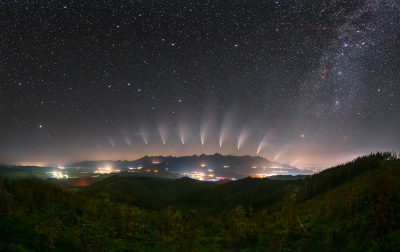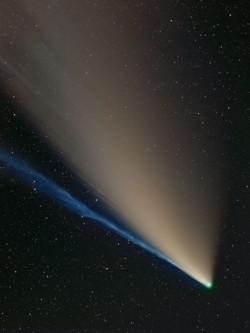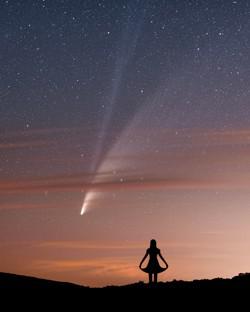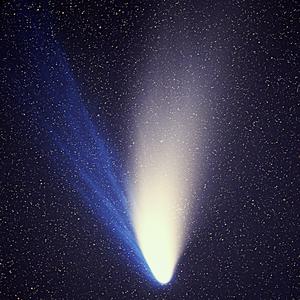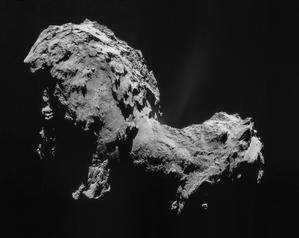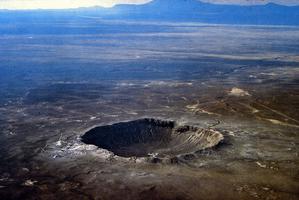Glossary term: Comète
Description: Une comète est un petit objet du système solaire constitué d'un noyau composé d'un mélange de différents types de glace et de matériaux rocheux et poussiéreux - une boule de neige sale. La taille des noyaux de comète peut varier de quelques centaines de mètres à des dizaines de kilomètres. La plupart des comètes ont des orbites très elliptiques. Lorsque la comète s'approche du Soleil, une partie de la glace de surface s'évapore et est repoussée par le vent solaire pour former les caractéristiques distinctives de la coma et de la queue. Les comètes sont visibles grâce à la réflexion de la lumière solaire sur la coma, la queue ou (pour les comètes éloignées du Soleil) le noyau. Les comètes sont classées comme "périodiques" ou "à courte période" si leur passage a été observé plus d'une fois ou si l'on sait que leur période est inférieure à 200 ans, et comme "non périodiques" dans le cas contraire.
Related Terms:
See this term in other languages
Term and definition status: The original definition of this term in English have been approved by a research astronomer and a teacher The translation of this term and its definition is still awaiting approval
The OAE Multilingual Glossary is a project of the IAU Office of Astronomy for Education (OAE) in collaboration with the IAU Office of Astronomy Outreach (OAO). The terms and definitions were chosen, written and reviewed by a collective effort from the OAE, the OAE Centers and Nodes, the OAE National Astronomy Education Coordinators (NAECs) and other volunteers. You can find a full list of credits here. All glossary terms and their definitions are released under a Creative Commons CC BY-4.0 license and should be credited to "IAU OAE".
If you notice a factual or translation error in this glossary term or definition then please get in touch.
Related Media
Neowise's metamorphosis, by Tomáš Slovinský and Petr Horálek, Slovakia
Credit: Tomáš Slovinský and Petr Horálek/IAU OAE
License: CC-BY-4.0 Creative Commons Attribution 4.0 International (CC BY 4.0) icons
Comet C/2020F3 (Neowise) with separate dust and ion gas tails and a green glowing coma, by Dietmar Gutermuth, Germany
Credit: Dietmar Gutermuth/IAU OAE
License: CC-BY-4.0 Creative Commons Attribution 4.0 International (CC BY 4.0) icons
Hello Comet, shall we dance?, by Robert Barsa, Slovakia
Credit: Robert Barsa/IAU OAE
License: CC-BY-4.0 Creative Commons Attribution 4.0 International (CC BY 4.0) icons
Comète Hale-Bopp
Credit: E. Kolmhofer, H. Raab ; Observatoire Johannes Kepler, Linz, Autriche credit link
License: CC-BY-SA-3.0 Creative Commons Attribution - Partage dans les Mêmes Conditions 3.0 non transposé icons
La comète 67P/Tchourioumov-Guérassimenko
Credit: ESA/Rosetta/NAVCAM credit link
License: CC-BY-SA-3.0-IGO Creative Commons Attribution - Partage dans les Mêmes Conditions 3.0 Organisations Internationales icons
Related Activities
Meteoroids, Meteors and Meteorites
astroEDU educational activity (links to astroEDU website) Description: Unveiling the mystery of "shooting stars": meteors, meteorites and meteroids
License: CC-BY-4.0 Creative Commons Attribution 4.0 International (CC BY 4.0) icons
Tags:
Geology
Age Ranges:
6-8
, 8-10
, 10-12
, 12-14
Education Level:
Middle School
, Primary
Areas of Learning:
Interactive Lecture
Costs:
Low Cost
Duration:
1 hour 30 mins
Group Size:
Group
Skills:
Analysing and interpreting data
, Asking questions
, Communicating information
, Engaging in argument from evidence
Measuring the average speed of a comet
astroEDU educational activity (links to astroEDU website) Description: Using telescope images of comet C/2019 Y4 we calculate its average speed and understand what a physical quantity is
License: CC-BY-4.0 Creative Commons Attribution 4.0 International (CC BY 4.0) icons
Tags:
Software
, average speed
Age Ranges:
12-14
, 14-16
, 16-19
, 19+
Education Level:
Secondary
Costs:
Free
Duration:
1 hour 30 mins
Group Size:
Group
Skills:
Analysing and interpreting data
, Developing and using models
, Engaging in argument from evidence
